Taken from Sister Ann Victoria Wasylina’s wake reflection. Sister died October 12, 2010.
Irene Wasylina in 1942, just as she came to Austria.
Born June 11, 1924, Irena Wasylina was the only daughter of the blacksmith, Basil Wasylina, and his wife, Anna. Growing up in Duliby, Stryj, in the Polish Ukraine, Irena had two brothers, Peter – also a blacksmith – and Nicholas, a cobbler. Irena was baptized and confirmed in the Byzantine Rite at St. Basil Church, and grew up in a faith-filled family. Sadly, when she was eight, she lost her father to cancer.
In 1953, when asked to recount how she had found her vocation, Irena would write: “When I was little girl in Poland, one time I asked my mother, ‘How would you like it if I go into a convent and give myself to God and serve him?’ My mother was very happy.”
In her recollections, she continued that in 1938 communism came to Poland and all the cloisters and churches were shuttering from Russians, with some priests and sisters being deported. All was sadness and quiet and they could hear no more church bells. Shortly after the communists came, the Nazis invaded Poland in 1939, and Irena’s school years were over. She was forced to quit school and go to work in a cord wood factory, a hardship that ultimately benefited her family, for she was allowed to carry a bonus of wood home with her those cold nights.
Irene in Austria, 1943.
Then one morning in 1942, Irena’s life was catapulted in yet another direction. As she came home from Mass, her mother was waiting with an order from the Nazis for Irena to board a train bound for a German work camp in Austria. From the train, Irena saw her mother for the last time and by 1944 she would hear from her no more. In Austria, the Germans lined up the trainload of workers who were then chosen at random by those who had requested workers. Irena had the God-graced good fortune to be chosen by Johann Stieglebauer, a good Catholic farmer.
The Stieglbauer Family: Johann and Rosa, with children Fritz, Hans, Pepi. Irene also took care of the baby Rosie.
For the next eight years, through the end of the war and beyond, Irena worked with the Stieglbauers cutting hay, tending the farm, learning the German language, and caring for the baby – Rosa – together with the other Stieglbauer children – Fritz, Hanzel, and Pepi.
While Irena’s joyful nature survived the war, she experienced tragedy and real danger nonetheless. She would learn later that both her brothers were lost in the war, and that she almost lost her mother when she was interred at Auschwitz. Although her mother, Anna Wasylina, was later released, she had allowed herself to be transported to the camp in place of the “other” Anna Wasylina, giving that unknown Anna a chance to escape. At the war’s end, Irena herself narrowly escaped repatriation, or capture, at the hands of returning Bulgarian and Russian soldiers by hiding under the back staircase and fleeing through hayfields to the neighboring hills.
Irene with the children.
By 1950, Irena knew it was time to move on to the next phase of her life. She contacted the Catholic Relief Services and signed up to come to America. When she heard that she was coming to an Academy, she made it abundantly clear that she was not going to go to school. She was a grown woman and was coming to work.
Once again, Irena was in a new place, confronting an unfamiliar culture and language; she would ultimately be able to communicate in five languages – Ukrainian, Polish, Russian, German, and English. In the meantime, however, Irena was in a new country, surrounded by “nuns,” still searching for word of her family, and trying to learn that new language. Sister Casimir Czurles, a Mount Saint Joseph Ursuline who spoke Polish, was a life-saver for Irena, serving as a translator and helping her find her way. Still, the Sisters noted that every evening would find Irena on the porch or in a swing softly, sadly, singing the songs of home.
Yet, in all this time, Irena had never lost her earlier certainty that the “best life” for her was in the convent. After she had been at the Mount for a few years, in an attempt to validate this choice, Irena spent six months in St. Louis, working at a factory to learn about the other side of life. At this time, she was sponsored, befriended, and supported by Sister Victoria Brohm and the Brohm family. Finally, when, in response to a request from Mount Saint Joseph, word came from the Sacred Congregation for the Oriental Church that Irena Wasylina could be admitted to their novitiate and “conform with the Latin Rite in all ways,” the path was paved for Irena to begin her next life’s journey if that were still her choice.
Irene as a postulant.
From St. Louis, Irena would write to Mother Ambrose, “My heart still wants [to go] to convent; can I come home in August?” So, she came home to Mount Saint Joseph in August and by September, Irena entered the postulancy. On August 14, 1954, she was invested as Sister Ann Victoria. Later, Sister Ann Victoria would write that she did not really remember her Novitiate, because she was in the dairy all the time, but that she had “good and kind classmates.”
In fairly rapid succession, three significant events for Sister Ann Victoria transpired:
~ she made temporary vows on August 15, 1956;
~ she became a naturalized American Citizen on February 13, 1957; and
~ in the summer of 1957, she returned from her first mission as housekeeper at St. Columba in Louisville to begin her 30-year ministry in the Mount Saint Joseph dairy.
She made her final vows on August 15, 1959, and was already quite famous for her artistically crafted, individually stamped butter pats and the best cottage cheese around. Sister Ann Victoria trained many novices in proper practices for filling the pasteurizer and keeping the dairy clean; in the later years, when record players were allowed, the dairy always had some music.
In celebration of her 25th Jubilee, Sister Ann Victoria went home again – not to Poland, still under communist rule – but to Austria and the Stieglbauers. She was more than warmly welcomed and remembered; and she discovered that some clothes she had sent as gifts in the war recovery years had never been worn, but, as the family said, had been carefully packed away as relics, just “because they were from you.”
Sister Ann Victoria decorating butter.
After thirty years in the dairy, Sister Ann Victoria was given the opportunity to spend some time at St. Teresa Parish in Grants, New Mexico, working in outreach to the sick and elderly. She fell in love with the high mesas and their people, and the mesas and people returned that love to her. In 1988, Sister Ann Victoria came home to the Mount where she was active in personal and pastoral care and ministered in the Guest House as well. In 1995, she retired from active ministry, joining our powerhouse of prayer.
Sister Ann Victoria in Grants, New Mexico.
Sister ended her autobiography with a simple, closing prayer:
Jesus, Mary, and Joseph, I give you my heart and soul.
Jesus, Mary, and Joseph, assist me in my last hour.
Jesus, Mary, and Joseph, may I breathe forth my soul in peace. Amen
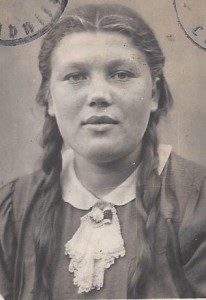
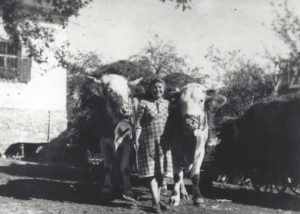
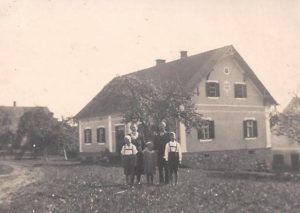
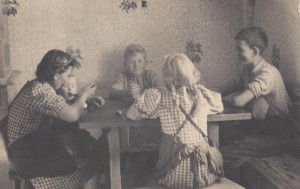



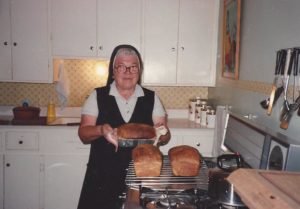
Comments
I remember Sister Ann Victoria. I was a student at the academy in 1952 & 1953 – then in the novitate 1953 and 1954. I remember her well. Thanks so much for sharing I enjoyed reading this very much. My husband is a cousin to Sister Cheryl Clemons
Sr. Ann Victoria was blessed with a beautiful alto voice. One hymn to Our Blessed Mother was a favorite which she would readily sing whenever asked. Sung in her native tongue it was a special treat on feasts of Our Lady. Although it had a wide range she sang it with the greatest of ease — unhurried and prayerfully.
I really enjoyed reading about Sister Ann Victoria’s life. She was always smiling!!